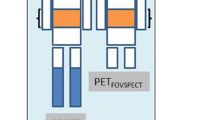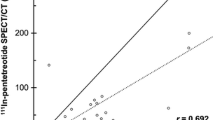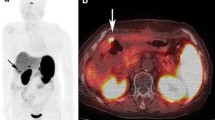Abstract
A patient with a history of a jejunal carcinoid and resection of liver metastases underwent CT, MRI and FDG-PET as well as somatostatin receptor scintigraphy using111In-pentetreotide during follow-up. Octreoscan demonstrated one extrahepatic abdominal lesion with pathologic uptake, while the other imaging modalities failed to show a corresponding abnormality. For verification of this finding123I-MIBG scintigraphy was performed. The MIBG scan confirmed the octreotide positive lesion and showed an additional abdominal lesion in the SPECT study. According to the scintigraphic results, radioguided surgery (RGS) was implemented using123I-MIBG. This resulted in the intra-operative detection of two para- and pre-aortic lymph node metastases by the gamma probe and successful resection. An additional preaortal lymph node, suspicious by palpation, was also removed. Histopathology revealed metastases of a carcinoid tumor in all three specimens. In conclusion, the use of RGS facilitates successful removal of carcinoid metastatic lesions despite negative conventional imaging results. Secondly,123I-MIBG scintigraphy may provide advantages over octreoscan for preoperative localization as well as radio-guided surgery of neuroendocrine metastatic lesions, if the involved site is located in proximity to highly octreotide-avid organs such as the kidneys or spleen.
Similar content being viewed by others
References
Adams S, Baum RP. Intraoperative use of gamma-detecting probes to localize neuroendocrine tumors.Q J Nucl Med 2000; 44: 59–67.
Creutzfeldt W, Stöckmann F. Carcinoids and carcinoid syndrome.Am J Med 1987; 82: 4–15.
Feldman JM, Blinder RA, Lucas KJ, Coleman RE. Iodine-131 metaiodobenzylguanidine scintigraphy of carcinoid tumors.J Nucl Med 1986; 27: 1691–1696.
Hoefnagel CA, den Hartog Jager FC, Taal BG, Abeling NG, Engelsman EE. The role of 1-131-MIBG in the diagnosis and therapy of carcinoids.Eur J Nucl Med 1987; 13: 187–191.
Adolph JM, Kimmig BN, Georgi P, zum Winkel K. Carcinoid tumors: CT and I-131 meta-iodo-benzylguanidine scintigraphy.Radiology 1987; 164: 199–203.
Chatal JF, Le Bodic MF, Kraeber-Bodere F, Rousseau C, Resche I. Nuclear medicine applications for neuroendo-crine tumors.World J Surg 2000; 24: 1285–1289.
Kaltsas G, Korbonits M, Heintz E, Mukherjee JJ, Jenkins PJ, Chew SL, et al. Comparison of somatostatin analog and meta-iodobenzylguanidine radionuclides in the diagnosis and localization of advanced neuroendocrine tumors.J Clin Endocrinol Metab 2001; 86: 895–902.
Kwekkeboom DJ, Krenning EP. Somatostatin receptor imaging.Semin Nucl Med 2002; 32: 84–91.
Adams S, Baum RP, Wenisch HJC, Lorenz M, Staib-Sebler E, Herrmann, et al. Intraoperative gamma probe detection of neuroendocrine tumors.J Nucl Med 1998; 39: 1155–1160.
Burke AP, Thomas RM, Elsayed AM, Sobin LH. Carcinoids of the jejunum and ileum: an immunohistochemical and clinicopathologic study of 167 cases.Cancer 1997; 79: 1086–1093.
Olney JR, Urdaneta LF, Al-Jurf AS, Jochimsen PR, Shirazi SS. Carcinoid tumors of the gastrointestinal tract.Am Surg 1985;51:37–41.
Saha S, Hoda S, Godfrey R, Sutherland C, Raybon K. Carcinoid tumors of the gastrointestinal tract: a 44-year experience.South Med J 1989; 82: 1501–1505.
Andaker L, Lamke LO, Smeds S. Follow-up of 102 patients operated on for gastrointestinal carcinoid.Acta Chir Scand 1985; 151:469–473.
Nocaudie-Calzada M, Huglo D, Carnaille B, Proye C, Marchanddise X. Comparison of somatostatin analogue and metaiodobenzylguanidine scintigraphy for the detection of carcinoid tumours.Eur J Nucl Med 1996; 23:1448–1454.
Taal BG, Hoefnagel CA, Valdes Olmos RA, Boot H. Combined diagnostic imaging with131l-metaidobenzyl-guanidine and111In-pentetreotide in carcinoid tumours.Eur J Cancer 1996; 32: 1924–1932.
Ramage JK, Williams R, Buxton-Thomas M. Imaging secondary neuroendocrine tumours of the liver: comparison of I123 metaiodobenzylguanidine (MIBG) and In111-labelled octreotide (Octreoscan).Q J Med 1996; 89: 539–542.
Ohrvall U, Westlin JE, Kjellberg F, Nilsson S, Juhlin C, Rastad J, et al. A gamma detector probe withex vivo detection of carcinoid tumors superior to intraoperative palpation.Cancer 1997; 80: 2495–2500.
Ohrvall U, Westlin JE, Nilsson S, Juhlin C, Rastad J, Lundqvist H, et al. Intraoperative gamma detection reveals abdominal endocrine tumors more efficiently than soma-tostatin receptor scintigraphy.Cancer 1997; 80: 2490–2494.
Gibril F, Reynolds JC, Chen CC, Yu F, Goebel SU, Serrano J, et al. Specificity of somatostatin receptor scintigraphy: a prospective study and effects of false-positive localizations on management in patients with gastrinomas.J Nucl Med 1999; 40: 539–553.
Reubi JC, Kvols LK, Waser B, et al. Detection of somatostatin receptors in surgical and percutaneous needle biopsy samples of carcinoids and islet cell carcinomas.Cancer Res 1990; 50: 5969–5977.
Adams S, Baum R, Rink T, Schumm-Drager PM, Usadel KH, Hor G. Limited value of fluorine-18 fluorodeoxyglucose positron emission tomography for the imaging of neuroendocrine tumours.Eur J Nucl Med 1998; 25: 79–83.
Belhocine T, Foidart J, Rigo P, et al. Fluorodeoxyglucose positron emission tomography and somatostatin receptor scintigraphy for diagnosing and staging carcinoid tumours: correlations with the pathological indexes p53 and Ki-67.Nucl Med Commun 2002; 23: 727–734.
Le Rest C, Bomanji JB, Costa DC, Townsend CE, Visvikis D, Ell PJ. Functional imaging of malignant paragangliomas and carcinoid tumours.Eur J Nucl Med 2001; 28: 478–482.
Markou A, Manning P, Kaya B, Datta SN, Bomanji JB, Conway GS. [18F]fluoro-2-deoxy-D-glucose ([18F]FDG) positron emission tomography imaging of thymic carcinoid tumor presenting with recurrent Cushing’s syndrome.Eur J Endocrinol 2005; 152: 521–525.
Author information
Authors and Affiliations
Corresponding author
Rights and permissions
About this article
Cite this article
Yüksel, M., Eziddin, S., Ladwein, E. et al. 111In-pentetreotide and123I-MIBG for detection and resection of lymph node metastases of a carcinoid not visualized by CT, MRI or FDG-PET. Ann Nucl Med 19, 611–615 (2005). https://doi.org/10.1007/BF02985056
Received:
Accepted:
Issue Date:
DOI: https://doi.org/10.1007/BF02985056




